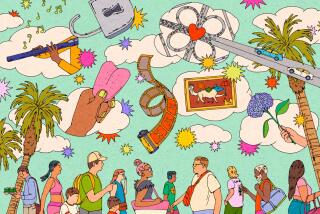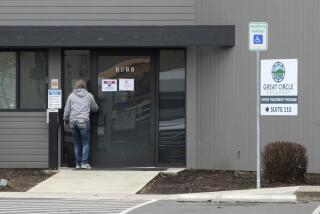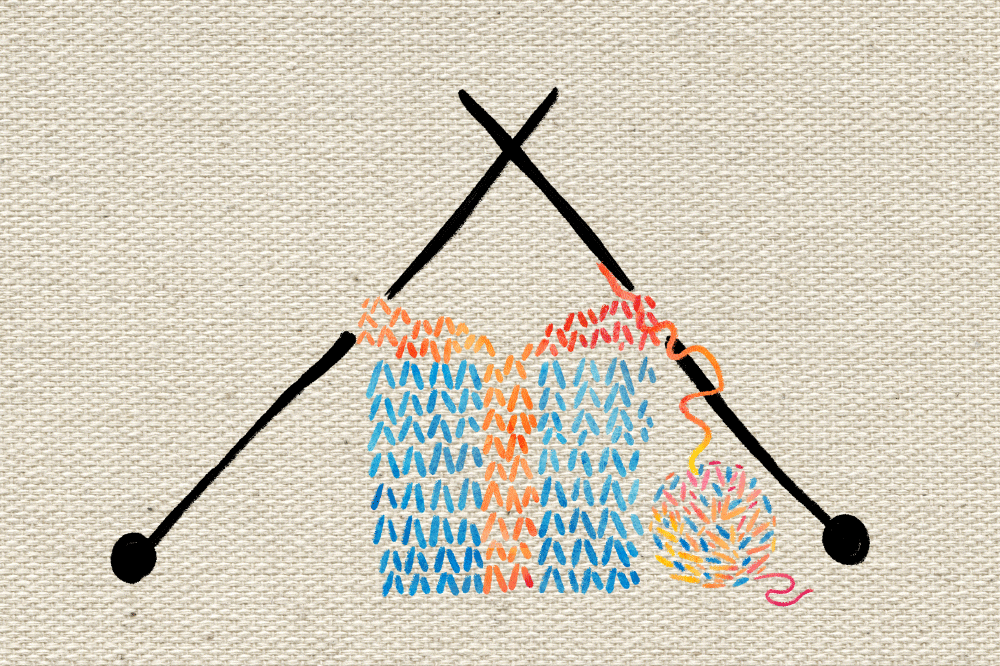High Court to Hear Drunk Law Appeal : 10-Year Sundance Decriminalization Fight Has Sparked Changes
Ten years ago, as the case of Sundance vs. Los Angeles Municipal Court was about to be filed, Robert Sundance himself was an alcoholic living on the streets of Skid Row.
Today, his 10-year quest to get public drunkenness decriminalized reaches the California Supreme Court, where justices will hear oral arguments in what is already a landmark case.
The 58-year-old Hunkpapa Sioux Indian who walks into court to listen to his attorney and attorneys for Los Angeles city and county is a vastly different man from the homeless alcoholic who was arrested as a public inebriate more than 500 times in 25 years.
Sundance has been sober for nine years, and now earns $21,000 a year as director of the Indian Alcoholism Commission of California, which lobbies to improve alcoholism programs in Los Angeles County. It is the first and only job he has ever held.
At the same time, Los Angeles’ system for handling public inebriates has vastly changed as well, as a lower-court ruling on the Sundance case revolutionized the way drunks are handled by the criminal justice system.
Because of the case, the number of Los Angeles Police Department arrests for public drunkenness dropped from 50,595 in 1975, when the case was filed, to 1,113 last year.
The case brought public scrutiny to the plight of Skid Row drunks, now more visible because they are not routinely arrested, and the first wave of attention to the plight of the homeless in general.
“The public inebriate was the first sector of the homeless to be recognized,” said Edward Eisenstadt, director of alcoholism and residential services for the Volunteers of America, which operates a detoxification unit and “sobering station” at the Weingart Center on Skid Row.
The center opened in 1983, Eisenstadt added, as a result of the Sundance case.
“When the (first) Sundance decision came out (1978), it was a crisis for Skid Row,” he said. “The police capability was severely limited; the Volunteers of America had a pilot program where we could take about 20 people a day. The rest were just laying on the street.”
Public drunkenness is a misdemeanor violation of state Penal Code Section 647 (f), which defines the crime as being “found in any public place under the influence of intoxicating liquor . . . in such a condition that he is unable to exercise care for his own safety.”
The longstanding police practice was to routinely arrest public inebriates, often transporting them in so-called “B-wagons”--vans with enclosed steel compartments--and hold them in large cells known as “drunk tanks.”
Sundance case sought to halt the “revolving door” system of arresting and jailing chronic inebriates, which Sundance claimed denied them due process. After an eight-week trial in Superior Court, Judge Harry L. Hupp ruled in 1978 that improvements should be made in the handling of public drunk arrestees to ensure their constitutional rights.
Hupp ordered that they be handled the same as anyone arrested for a misdemeanor, that they should be provided, for example, with beds and proper food. Calling alcoholism a disease, he ordered medical screening within an hour of arrest by trained personnel and said the B-wagons should be padded and not allowed to carry more than 10 people at a time.
However, Sundance also sought to remove public drunkenness from the Penal Code, and when Hupp’s decision did not do that, his attorney, Timothy McFlynn, took the case to the state Court of Appeal.
The appellate court also refused to declare the law unconstitutional, so Sundance again appealed, to the state Supreme Court.
As of now, 35 states have decriminalized public drunkenness, McFlynn said.
‘Being Helpless’
“The California Penal Code says being helpless in public is a crime,” he said. “We’re saying it isn’t. It’s a public health problem.”
Deputy City Atty. Denise Beaudry said the City of Los Angeles has argued for the last 10 years that it is the Legislature’s responsibility, not the judiciary’s, to decide “whether or not a particular act is a public offense.”
In addition, she said, “the city’s position is essentially that without a public offense for public drunkenness, police officers would be powerless to remove severely intoxicated people from public places.”
The problem of public drunks has already been felt on downtown Los Angeles streets since the 1978 ruling and the resulting reduction in arrests.
“We were inundated with complaints,” said Police Capt. Billy R. Wedgeworth of Central Division, which patrols downtown’s Skid Row, in the aftermath of the earlier Sundance decisions. The problem still exists.
Found in Doorways
“They’re lying in doorways of merchants, they are relieving themselves in areas where they shouldn’t,” he said. “What we have is a mandate from the court, without any proper alternative “
The 2-year-old Weingart Center, created to help solve the problem, is the only downtown detoxification service, but it has only 52 beds.
“It’s absolutely not enough,” Eisenstadt said. “Based on our waiting lines, we need at least 100 detoxification beds and approximately 300 more residential recovery beds.”
Monday, as his lawyer prepared for court, Sundance walked the streets of Skid Row. He still lives there at the Hotel Rosslyn, because “that’s where I lived when I first became sober.”
He is called serious and somber by those who know him and totally devoted to the cause of helping alcoholics. It is rare to see him smile.
Most Strangers
Most of the drunks he encounters now are strangers, many Spanish-speaking, “a lot of guys I don’t even know,” he said.
Almost wistfully, he added, “In the old days I used to know everybody.”
“Do you know who I am?” he asked a man standing outside the Midnight Mission.
“No, I don’t,” the man shrugged.
Sundance was born in 1927 on the Standing Rock Sioux Reservation in Wakpala, S.D. He wandered the country, from one Skid Row to the next, after he received a dishonorable discharge from the Air Force at 22. He has recently gotten that discharge changed to honorable, he said.
In the early 1960s, he said, he was in Los Angeles, routinely being arrested, and “decided to do something about the problem.”
“My main focus was on cruel and unusual punishment,” Sundance said.
He had little education and no knowledge of law, he said.
Read Dictionaries
“I started reading dictionaries, mainly, and whatever I could get in the libraries in jail.”
About 1970, he said, he changed his name from Rupert Sibley McLaughlin to Robert Sundance.
“I made up my mind I was going to change the system,” he explained, “but I had no friends, no money, no education. I had a feeling I could win though, if only I could stay alive.
“So I thought, what can give me the strength to stay on? Then, I thought, the sun dance is one of the most sacred ceremonies of the Sioux. It’s an annual ritual, that rejuvenates you, gives you the strength to carry on.”
So he took the name, as a symbol to help himself. Eventually, he started writing petitions, in pencil on lined sheets of paper, in a rounded, childlike script. Most, he said, were ignored or torn up by jail guards. However, the 80th one, which he sent to federal Judge Warren J. Ferguson, as Sundance put it, “struck lightning.”
Petition Forwarded
Ferguson sent the petition to the Center for Law in the Public Interest for their consideration. Attorney McFlynn had started working there six weeks before. Now 42, he heads the Public Justice Foundation, which he founded in 1982.
A Stanford Law School graduate who had worked as a prosecutor for Los Angeles County, McFlynn recently recalled that the other lawyers in his office were not interested in the Sundance petition. He was “asked to politely decline it with a letter . . . back to the judge,” he said.
When McFlynn read it, however, he jumped in his car and drove down to see Sundance at the County Jail. He remembers finding the tall Sioux “clear-thinking, poised and proud,” and he persuaded the center to take the case.
However, Sundance was “actively drinking” then, McFlynn added.
Bars Closed
“In order to find Bob (Sundance) or meet Bob, he would call my number in the evenings, usually after 2 a.m. after the bars had closed, and we’d make a plan to meet on the street somewhere. Or I would call the inmate locating service of the County Jail, routinely, until I found Bob somewhere in the system.”
Through a friend, he found out about a case worker named Jill Halverson, who went on to start the Downtown Women’s Center, the first to bring care and shelter to the women of Skid Row, in 1978.
“I went to Jill and asked her if she would consider becoming Bob’s counselor so he could become sober.”
Through Halverson’s help, Sundance eventually agreed to enter detoxification, and in 1978, he went to work for the Indian Alcoholism Commission, which is funded by the Los Angeles County Office of Alcohol Programs.
‘Worst Problem’
Sundance chose it, he explained, because “Indians have the worst problem with alcohol of any ethnic group or race.”
Whatever the decision of the Supreme Court, Sundance will continue to campaign on behalf of alcoholics, he said.
More to Read
The biggest entertainment stories
Get our big stories about Hollywood, film, television, music, arts, culture and more right in your inbox as soon as they publish.
You may occasionally receive promotional content from the Los Angeles Times.










